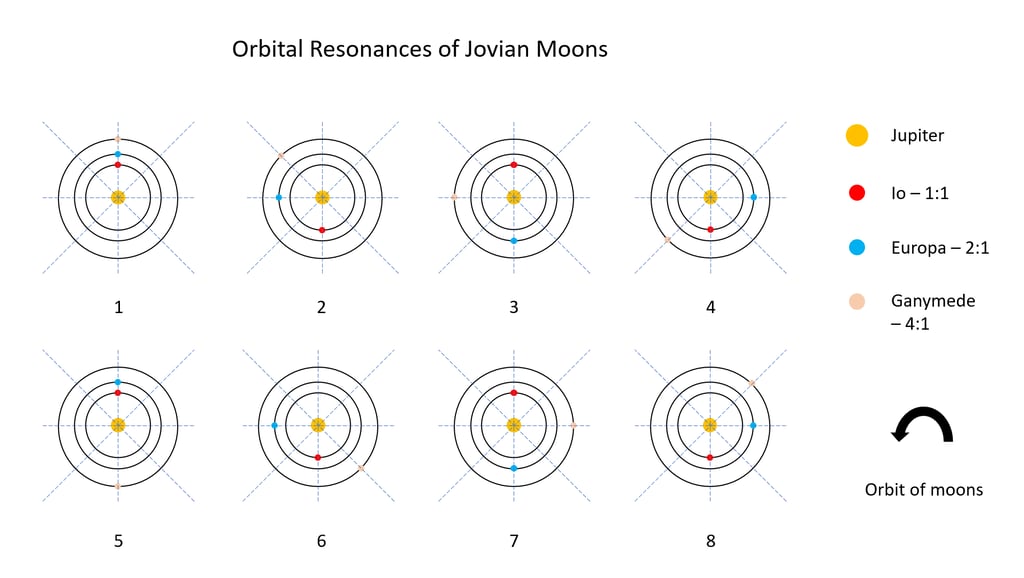Tides Across Worlds: The Moon's Drift and the Pulse of Distant Oceans
Did you know that the very tides that pull at our shores are slowly pushing the Moon away from us? Tidal forces between the Earth and Moon not only shape our oceans but also drive the Moon’s gradual drift. These same forces, on distant exoplanets, may act as hidden engines—heating interiors, driving volcanism, and perhaps sustaining life. In this post, we explore the physics behind tidal interactions, the story of our Moon’s evolution, and how tidal heating could turn otherwise cold, barren worlds into havens for habitability.
ASTRONAUTICA
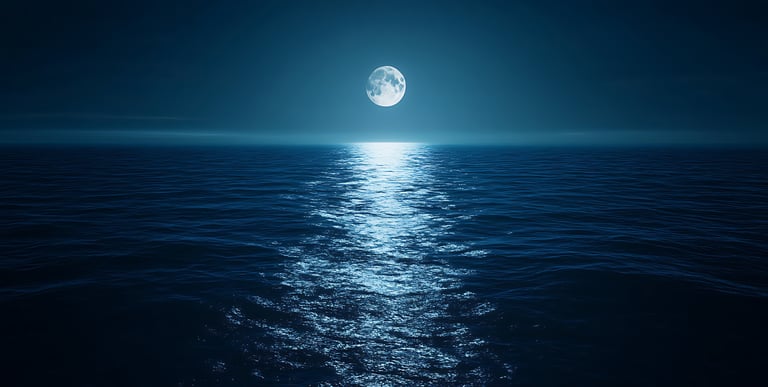

The night sky, adorned with countless twinkling stars, is a breathtaking tapestry that inspires awe and wonder in all who gaze upon its beauty. Amid the myriad sparkling jewels strewn by the velvety expanse of the night sky, the ethereal glow of the moon bestows an enchanting aura upon the celestial canvas; a silent sentinel, a beacon of beauty that captivates hearts and minds alike. How tragic it would be if the Moon were ever taken away, for it is a silent companion that weaves dreams, guides tides and whispers secrets to the night.
In 1969, NASA’s Apollo missions installed reflective panels on the Moon. This allowed researchers to measure the time taken by lasers sent to the Moon to bounce back to Earth. The results showed that the Moon has been drifting away from the Earth at about 3.8 cm per year. Luckily, this is not a rate to be alarmed about, but the curious among you might want to know the reason. Once again, it turns out that it has all got to do with tides.
You might know that the Moon is tidally locked to the Earth. Tidal locking, also known as gravitational locking or synchronous rotation, is the phenomenon where the same side of an astronomical body always faces another due to their mutual gravitational interaction. As the Moon revolves around the Earth, it exerts tides on, and experiences tides due to the Earth. Consequently, the Earth and the Moon are slightly bulged along the line joining their centres. This is the equilibrium configuration of a planet-moon system. We know today that the Moon rotates and revolves around the Earth counterclockwise when viewed from the North Pole (prograde motion1). Also, the Moon is believed to have had a faster rotation rate shortly after its formation than it does today. This means that the bulge of the Moon would have tended to lag behind the line joining the Earth’s centre to the Moon’s due to inertia (tidal friction2). Consequently, Earth’s gravitational pull would have exerted a torque on the Moon that would slow down its rotational speed by trying to pull the bulge towards the equilibrium position. Although these effects were minuscule, they would bring about a significant change over astronomical timescales. This would have continued until the Moon began synchronous rotation, after which no torque would be exerted as equilibrium was attained. This is why we always see the same side of the Moon. The process is estimated to have taken a few hundred million years – relatively early in the Moon’s history. If the Moon had begun rotating more slowly than it was revolving around the Earth, the latter’s gravity would have sped up the Moon’s rotation until it was tidally locked.
The Moon takes about 27.3 days to complete one revolution around the Earth. This is known as its sidereal month. However, due to the Earth’s own orbit around the Sun, the Moon appears to take about 29.5 days to complete one revolution. This is known as its synodic month (lunar month). The Earth, therefore, rotates much faster than the Moon orbits it, so it is not tidally locked to the Moon. This means the Earth’s tidal bulge leads the line joining its centre to the Moon’s. As a result, the Moon’s gravity exerts a torque on the Earth, slowing down its rotation. This consequence of tidal friction is known as tidal braking. This has been going on for billions of years and is why the day was slightly shorter in the Neoproterozoic age; it is also why days would be longer millions of years from now. 3
1* Prograde motion occurs when a celestial object, such as a planet or moon, moves in the same direction as the rotation of the body it orbits. For example, when observing the planets in our solar system from Earth, most appear to move from west to east relative to the background stars over time. This is prograde motion. In the context of moons orbiting planets, prograde motion means that the moon orbits in the same direction as the planet's rotation.
Retrograde motion, on the other hand, occurs when a celestial object revolves in the opposite direction to the rotation of its primary. In the Solar System, the orbits of all planets and most other objects, except many comets, are prograde.
2* Tidal friction arises from the cyclic changes in gravitational attraction experienced by a celestial body as it orbits another. This strain leads to friction between the solid crust of a planet or satellite, resulting in the release of heat in exchange for rotational or orbital energy. On Earth, tidal friction prevents the tidal bulge from remaining directly beneath the Moon.
3* Geological evidence, such as the distribution of ancient coral reefs and sedimentary layers, provides valuable insights into Earth's past rotation rates. These records suggest that Earth's days were shorter in the distant past than today. One aspect of this evidence comes from the study of ancient coral reefs. Coral reefs grow in shallow marine environments, and their growth patterns are influenced by various factors, including tidal rhythms and the duration of daylight. By analysing the growth patterns of ancient coral reefs preserved in the geological record, scientists can infer changes in Earth's rotation rate. For example, if coral reefs from a certain geological period exhibited growth patterns that suggest more frequent daily cycles, it would indicate that Earth's rotation was faster during that time.
4* Retrograde satellites are generally small and distant from their planets, except Neptune's satellite Triton, which is large and close. All retrograde satellites are thought to have formed separately before being captured by their planets.
5* The Hill sphere is the region around a primary body within which its gravitational attraction is stronger than the gravitational pull of any secondary body. The Earth’s Hill sphere is estimated to be around 1.5 million kilometres from its centre. At an average distance of 384,400 km, the Moon is well within the Earth’s Hill sphere.
6* The flexing of a metal can generate heat through a process known as mechanical hysteresis. When a metal is repeatedly flexed or bent, its crystalline structure undergoes deformation, generating a resistive internal friction. Each time the metal is flexed, some mechanical energy is converted into heat.
7* Orbital resonance is a phenomenon that occurs when two celestial bodies exert periodic gravitational influences on each other in a way that their orbital periods become related by a simple integer ratio. This results in a stable and predictable pattern of orbital motion over time.
One of the most famous examples of orbital resonance is the relationship between the moons of Jupiter, particularly the three innermost large moons: Io, Europa, and Ganymede. This trio of moons is in a 1:2:4 resonance, meaning that for every orbit completed by Ganymede, Europa completes two orbits, and Io completes four orbits

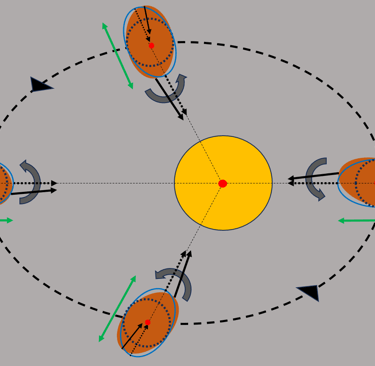
The figure shows a moon in orbit (clockwise) around its host planet.
The moon experiences varying amounts of tides due to the elliptical nature of its orbit. The closer it is to the planet, the larger its tidal bulge is. This continuous change in tidal strength mimics flexion over time, heating the moon in the process.
Notice that the actual bulge (brown) leads the intended bulge (blue). This gradually slows the moon's rotation (assuming prograde spin) until it becomes tidally locked to the planet.
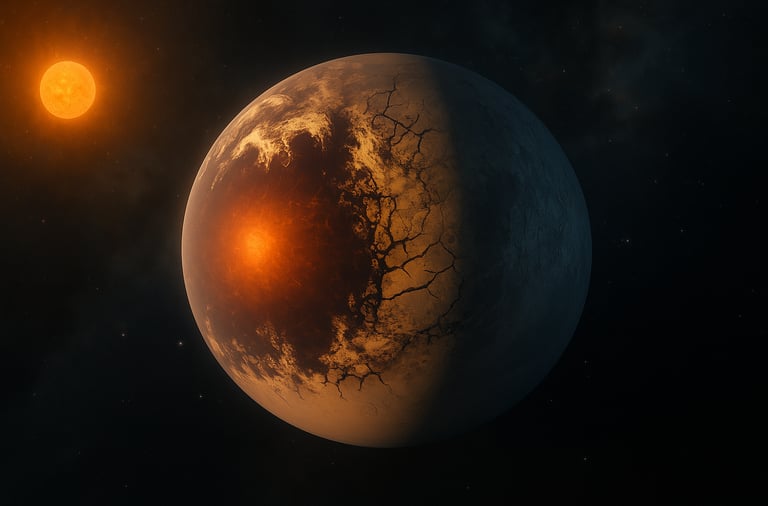

Courtesy: Asim Bukhari, Vecteezy
A well-studied case of this effect is that of Jupiter’s moon, Io, the most volcanically active site in the Solar System. Tidal heating is believed to be the primary cause of the geological activity of the Moon. It follows an elliptical orbit around Jupiter due to its orbital resonances7 with two other Galilean moons8, Europa and Ganymede. It taps Jupiter’s rotational energy by creating tides on it. A similar process goes on in Europa. Wrapped in a layer of water-ice crust, it has the smoothest surface of any known object in the Solar System, likely due to a water ocean that could be up to 100 km deep beneath the surface, which could potentially harbour extraterrestrial life. With minimal sunlight reaching its surface, it should have been frozen solid. Heat due to tidal flexing is believed to keep this ocean liquid. It could also create hydrothermal vents9, like on Earth, which researchers believe to be where life began. Tidal heating may be essential for life on exoplanets and rogue planets10, where other energy sources aren’t accessible (Many planet systems are based around dull red dwarfs).
Remarkably, life may be possible on tidally locked planets. Such planets would have endless days on one side and endless nights on the other. These are also called eyeball planets, as the side receiving perpetual daylight would be much hotter and brighter, and the thermal gradient would taper off as one moved away from the bright spot. Life in such hostile conditions is almost certainly impossible. However, the boundary between these two extremes could have more moderate climates that could support life. The presence of an atmosphere may be essential, as it would help distribute heat more evenly around the planet. This would also lead to strong winds flowing across the two extreme regions. In regions conducive to cloud formation, exotic forms of precipitation such as sulfuric acid rain may exist.
Remember that the angular momentum of the Earth-moon system remains conserved in the absence of an external torque. So, if the Earth’s rotation is slowing down, the lost angular momentum must be compensated somewhere. This is where the Moon gains angular momentum, causing it to move into a slightly outer orbit, which results in the Moon drifting away from the Earth, albeit at a snail’s pace. This phenomenon, known as tidal acceleration, is common in planet-moon systems. The larger of the two Martian moons, Phobos, is in a prograde motion; however, it revolves around Mars once in about 7 hours and 39 minutes, while a Martian day lasts about 24.6 hours. As a result, Mars’ tidal bulge lags the line joining its centre to Phobos’. The resultant torque decreases Phobos’ angular momentum, causing it to drop to inner orbits. It is expected to reach its Roche limit in a few million years, following which it will either disintegrate to form Martian rings or crash into the planet. A more curious case is that of Neptune’s largest moon, Triton.4 Triton is in a retrograde motion very close to Neptune. Strong tidal interactions try to put it in a prograde motion, which causes it to lose angular momentum: Tidal deceleration. Consequently, Triton is gradually moving inwards and will eventually reach its Roche limit, after which it is likely to form a new ring system.
Tidal locking is also one of the reasons no moon in our Solar System has its own moon. Since most moons are tidally locked to their planet, their tidal bulges would never be in line with that of their moons except when the three bodies are perfectly aligned. As a result, the primary moon would exert a torque on the sub moon, causing it to spiral inwards and crash. If the sub-moon were sped up instead, it would soon exit the Hill sphere5 of the moon. Simply put, the conditions required for moons to have their own moons are difficult to achieve. Even if there was such a system in the Solar System in the past, the unstable nature of the orbit would have likely caused the sub-moon to crash onto the parent moon. Interestingly, an asteroid named Ida (about 1.6 km wide) has a small moon named Dactyl. This is one of the first confirmed cases of an asteroid having a moon, although the stability of the orbit is uncertain.
Most planetary or satellite orbits are elliptical. This, coupled with tidal friction, has another remarkable consequence: Tidal heating. Also known as tidal working or tidal flexing, tidal heating occurs when a celestial body is subject to varying tidal stresses during its orbit, causing it to flex and consequently heat up. When a moon orbits around a planet elliptically, it experiences stronger tides at the periapsis, where it is stretched the most, than at the apoapsis, where it is stretched the least. As a result, the moon is continuously flexing in the course of its orbit, leading to its heating. This is similar to how a metal bar heats up when bent and restored repeatedly.6 Although the process is painstakingly slow, it can have a significant impact on the body’s temperature over astronomical timescales.
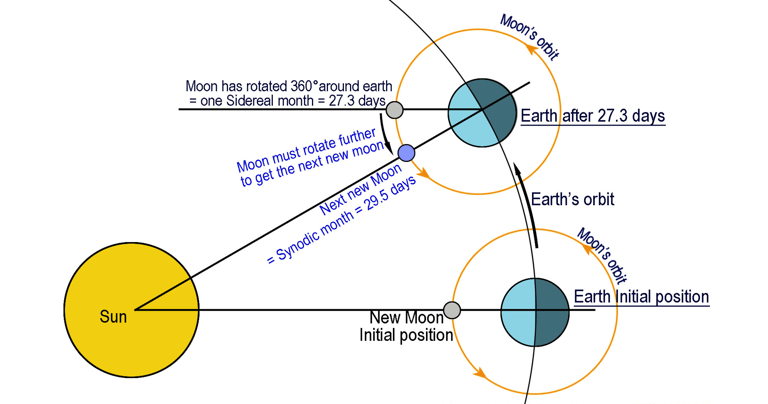

Courtesy: Astronomical Association of Queensland (eclipse.aaq.org.au)
Synodic and sidereal months
An artist's depiction of an eyeball Trappist exoplanet.
Tidally locked rogue planets receive perennial starlight on one side, while the other side is draped in eternal darkness. The boundary between two extremes on these 'Eyeball Earths' could be a Goldilocks zone, harbouring alien life.
8* The Galilean moons are the 4 largest moons of Jupiter discovered by the Italian astronomer Galileo Galilei in 1610: Io, Europa, Ganymede, and Callisto.
Io is the innermost of the Galilean moons and is the most volcanically active body in the Solar System.
Europa is the second Galilean moon and is known for its smooth, icy surface crisscrossed by dark streaks and cracks. Beneath its icy crust lies a global subsurface ocean, making Europa one of the most promising places in the solar system to search for signs of extraterrestrial life.
Ganymede is the largest moon in the Solar System and is even larger than the planet Mercury.
Callisto is the outermost of the Galilean moons and has a heavily cratered surface.
9* Hydrothermal vents are fissures on the ocean floor where heated, mineral-rich water emerges from beneath the Earth's crust. These vents are found in areas of tectonic activity, such as mid-ocean ridges, where tectonic plates spread apart and magma rises from the Earth's mantle. They support unique ecosystems that thrive in the extreme conditions of darkness, high pressure, and extreme temperatures found in the deep ocean
10* Rogue planets, also known as free-floating planets or orphan planets, are planetary-mass objects that do not orbit a star. Instead, they drift freely through the galaxy without being gravitationally bound to any star system. They are usually formed in isolation or were ejected from a planetary system in the past. They are difficult to detect as they are non-luminous and are not illuminated by a nearby star.
